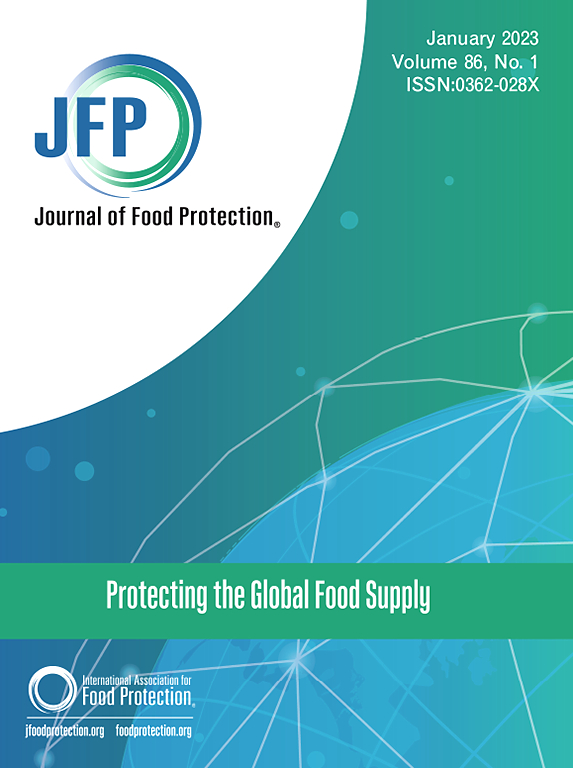Effect of Ultraviolet Water Treatment on Survival and Growth of Escherichia coli in Recirculating Hydroponic Systems
IF 2.8
4区 农林科学
Q3 BIOTECHNOLOGY & APPLIED MICROBIOLOGY
引用次数: 0
Abstract
Hydroponic nutrient solution can serve as a distribution mechanism for human pathogens to spread throughout an indoor farm since many hydroponic farms do not include water treatment during the crop growth period. Contamination can be introduced to recirculating nutrient solution through various routes, including growing media and worker contact. In leafy green production, it is common for nutrient solution to inadvertently contact produce during harvest or packaging. Therefore, it is critical that such water be free of human pathogens. Ultraviolet (UV) treatment of water could reduce contamination in nutrient solution without disrupting production or introducing new chemical inputs to the nutrient solution.
This study investigated the survival of generic Escherichia coli (E. coli) in hydroponic systems and assessed the efficacy of a 254 nm UV-C light treatment for E. coli reduction. Romaine lettuce was grown in hydroponic systems for six weeks. E. coli was inoculated into hydroponic nutrient solution at 6.02 average log CFU/mL UV-C treatments of water were performed biweekly. Hydroponic controls grew plants but received no UV-C treatment, and nonhydroponic controls neither grew plants nor received treatment. The efficacy of the treatment was assessed in terms of bacterial reduction in log CFU/mL.
The UV-C treatments resulted in significant (P < 0.001) reductions of 1.4–1.5 log10 CFU/mL of E. coli in the nutrient solution. However, the E. coli population declined naturally over the weeks following the inoculation, independent of the UV-C treatment. Survival of E. coli beyond one week is limited in the nutrient solution. Still, UV-C treatment has the potential to be used as a preventative safeguard for the microbial safety of the hydroponic production system by reducing contamination within the nutrient solution during crop growth. This can help maintain the safety of hydroponically grown fresh produce and reduce the likelihood of future outbreaks.
紫外线水处理对循环水培系统中大肠杆菌存活和生长的影响。
水培营养液可以作为人类病原体在室内农场传播的分布机制,因为许多水培农场在作物生长期间不包括水处理。通过各种途径,包括生长介质和工人接触,可将污染引入再循环营养液。在绿叶蔬菜生产中,营养液在收获或包装过程中无意中接触产品是很常见的。因此,这种水不含人类病原体是至关重要的。紫外线(UV)处理水可以减少营养液中的污染,而不会破坏生产或向营养液中引入新的化学物质。本研究调查了普通大肠杆菌(E. coli)在水培系统中的存活情况,并评估了254 nm UV-C光处理对大肠杆菌的还原效果。长叶莴苣在水培系统中生长6周。大肠杆菌以6.02平均log CFU/ml接种于水培营养液中。每两周对水进行UV-C处理。水培对照种植植株,但不接受UV-C处理,非水培对照既不种植植株,也不接受处理。以细菌减少量(log CFU/ml)评估治疗效果。UV-C处理显著(P < 0.001)降低了营养液中大肠杆菌1.4 ~ 1.5 log10 CFU/ml。然而,大肠杆菌数量在接种后的几周内自然下降,与UV-C处理无关。大肠杆菌在营养液中存活一周以上是有限的。尽管如此,UV-C处理有可能通过减少作物生长过程中营养液中的污染,作为水培生产系统微生物安全的预防性保障。这可以帮助维持水培种植的新鲜农产品的安全,并减少未来爆发疫情的可能性。
本文章由计算机程序翻译,如有差异,请以英文原文为准。
求助全文
约1分钟内获得全文
求助全文
来源期刊

Journal of food protection
工程技术-生物工程与应用微生物
CiteScore
4.20
自引率
5.00%
发文量
296
审稿时长
2.5 months
期刊介绍:
The Journal of Food Protection® (JFP) is an international, monthly scientific journal in the English language published by the International Association for Food Protection (IAFP). JFP publishes research and review articles on all aspects of food protection and safety. Major emphases of JFP are placed on studies dealing with:
Tracking, detecting (including traditional, molecular, and real-time), inactivating, and controlling food-related hazards, including microorganisms (including antibiotic resistance), microbial (mycotoxins, seafood toxins) and non-microbial toxins (heavy metals, pesticides, veterinary drug residues, migrants from food packaging, and processing contaminants), allergens and pests (insects, rodents) in human food, pet food and animal feed throughout the food chain;
Microbiological food quality and traditional/novel methods to assay microbiological food quality;
Prevention of food-related hazards and food spoilage through food preservatives and thermal/non-thermal processes, including process validation;
Food fermentations and food-related probiotics;
Safe food handling practices during pre-harvest, harvest, post-harvest, distribution and consumption, including food safety education for retailers, foodservice, and consumers;
Risk assessments for food-related hazards;
Economic impact of food-related hazards, foodborne illness, food loss, food spoilage, and adulterated foods;
Food fraud, food authentication, food defense, and foodborne disease outbreak investigations.
 求助内容:
求助内容: 应助结果提醒方式:
应助结果提醒方式:


